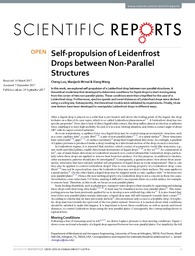
ATTENTION: The works hosted here are being migrated to a new repository that will consolidate resources, improve discoverability, and better show UTA's research impact on the global community. We will update authors as the migration progresses. Please see MavMatrix for more information.
Show simple item record
| dc.contributor.author | Luo, Cheng | |
| dc.contributor.author | Mrinal, Manjarik | |
| dc.contributor.author | Wang, Xiang | |
| dc.date.accessioned | 2018-02-01T02:26:43Z | |
| dc.date.available | 2018-02-01T02:26:43Z | |
| dc.date.issued | 20 September 2017 | |
| dc.identifier.citation | Published in Scientific Reports 7, Article number 12018: 1-12, 2017 | en_US |
| dc.identifier.uri | http://hdl.handle.net/10106/27118 | |
| dc.description.abstract | In this work, we explored self-propulsion of a Leidenfrost drop between non-parallel structures. A theoretical model was first developed to determine conditions for liquid drops to start moving away from the corner of two non-parallel plates. These conditions were then simplified for the case of a Leidenfrost drop. Furthermore, ejection speeds and travel distances of Leidenfrost drops were derived using a scaling law. Subsequently, the theoretical models were validated by experiments. Finally, three new devices have been developed to manipulate Leidenfrost drops in different ways. | en_US |
| dc.language.iso | en_US | en_US |
| dc.publisher | Springer Nature | en_US |
| dc.rights | Attribution 4.0 United States | * |
| dc.rights.uri | http://creativecommons.org/licenses/by/4.0/us/ | * |
| dc.subject | Leidenfrost Drops | en_US |
| dc.subject | Liquid drops | en_US |
| dc.subject | Derived theoretical model | en_US |
| dc.title | Self-propulsion of Leidenfrost Drops between Non-Parallel Structures | en_US |
| dc.type | Article | en_US |
| dc.publisher.department | Department of Mechanical and Aerospace Engineering, The University of Texas at Arlington | en_US |
| dc.identifier.externalLinkDescription | Original article available from article DOI | en |
| dc.identifier.doi | doi:10.1038/s41598-017-12279-6 | |
Files in this item
- Name:
- s41598-017-12279-6.pdf
- Size:
- 6.997Mb
- Format:
- PDF
- Description:
- PDF
- Name:
- license_rdf
- Size:
- 1.337Kb
- Format:
- application/rdf+xml
This item appears in the following Collection(s)
Show simple item record
Except where otherwise noted, this item's license is described as Attribution 4.0 United States



